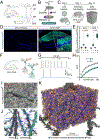Synaptic architecture of a memory engram in the mouse hippocampus
- PMID: 40112060
- PMCID: PMC12233322
- DOI: 10.1126/science.ado8316
Synaptic architecture of a memory engram in the mouse hippocampus
Abstract
Memory engrams are formed through experience-dependent plasticity of neural circuits, but their detailed architectures remain unresolved. Using three-dimensional electron microscopy, we performed nanoscale reconstructions of the hippocampal CA3-CA1 pathway after chemogenetic labeling of cellular ensembles recruited during associative learning. Neurons with a remote history of activity coinciding with memory acquisition showed no strong preference for wiring with each other. Instead, their connectomes expanded through multisynaptic boutons independently of the coactivation state of postsynaptic partners. The rewiring of ensembles representing an initial engram was accompanied by input-specific, spatially restricted upscaling of individual synapses, as well as remodeling of mitochondria, smooth endoplasmic reticulum, and interactions with astrocytes. Our findings elucidate the physical hallmarks of long-term memory and offer a structural basis for the cellular flexibility of information coding.
Conflict of interest statement
Figures







Update of
-
Synaptic architecture of a memory engram in the mouse hippocampus.bioRxiv [Preprint]. 2024 Apr 25:2024.04.23.590812. doi: 10.1101/2024.04.23.590812. bioRxiv. 2024. Update in: Science. 2025 Mar 21;387(6740):eado8316. doi: 10.1126/science.ado8316. PMID: 38712256 Free PMC article. Updated. Preprint.
References
-
- Holtmaat A, Svoboda K, Experience-dependent structural synaptic plasticity in the mammalian brain. Nat Rev Neurosci 10, 647–658 (2009). - PubMed
-
- Caroni P, Donato F, Muller D, Structural plasticity upon learning: regulation and functions. Nat Rev Neurosci 13, 478–490 (2012). - PubMed
-
- Magee JC, Grienberger C, Synaptic Plasticity Forms and Functions. Annu Rev Neurosci 43, 95–117 (2020). - PubMed
MeSH terms
Grants and funding
LinkOut - more resources
Full Text Sources
Molecular Biology Databases
Miscellaneous

